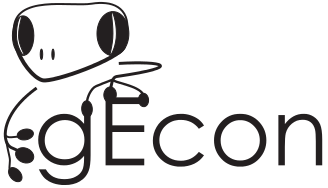General equilibrium economic modelling language and solution framework
A short introduction
- An introduction to gEcon
A short presentation containing an introduction to general equilibrium modelling and gEcon.
Users' guide and manual
Version 1.2.3
- Users' guide
Contains the beginner introduction to model creation process as well as detailed description of implementation and solvers.
- Manual
Automatically generated from R documentation.
Working papers
- On automatic derivation of first order conditions in dynamic stochastic optimisation problems
This note presents an algorithm for deriving first order conditions employed by gEcon.
- Smets-Wouters '03 model revisited — an implementation in gEcon
This paper presents an implementation of the well-known Smets-Wouters 2003 model for Euro Area using the gEcon package.
Installing gEcon
For details cf. Users' guide, chapter 2.
Prerequisites
- R version >=4.4.3
- Packages Matrix, MASS, nleqslv, Rcpp and methods.
Short installation instructions
In order to use gEcon you should first install the packages on which gEcon depends and then proceed to installing the gEcon R package. You can do this in two ways:
- through the command line interface — after changing current working directory to the folder where gEcon
package has been saved, it is sufficient to run a command:
> R CMD INSTALL gEcon_x.x.x.tar.gz
or
> R CMD INSTALL gEcon_x.x.x.zip,
- directly from R using installation options available in the GUI used.
FAQ
- Q: Is this software reliable?
- A: This software comes with no warranty (see the disclaimer in the licence), but we have put a lot of effort to test gEcon and compare its results with other software.
- Q: How does gEcon compare to Dynare?
- A: This short presentation along with the introductory slides should give Dynare users an idea about gEcon and how it compares to Dynare.
- Q: Why R?
- A: All popular DSGE toolboxes work within Matlab/Octave environments. The decision to break up with this tradition was carefully weighted. First, all vector programming languages/environments (Matlab, Octave, R, Ox) are built atop low level linear algebra and other numerical libraries such as BLAS and LAPACK. The main differences between them fall into the following categories: language features, number of extensions (libraries/packages), support, and user's base. Matlab and Octave offer much more functionality through their toolboxes in fields such as differential equations, optimisation etc. On the other hand, R language is more flexible (not everything has to be a matrix!) and has many more packages intended for analysis of the economic data. Flexibility of the language and natural synergies between economic modelling and econometric work have made R the environment of choice for this project.

